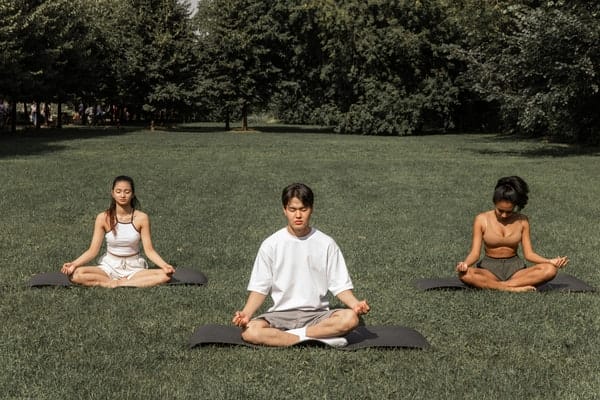
There are so many different styles of yoga; it’s hard to look at a studio’s class schedule and know what’s suitable for any one student. Here’s a short guide.
Look for yoga classes that are both challenging and enjoyable. It is best to take various styles to experience all the benefits of regular yoga practice, such as increased strength and stamina, reduced stress, and improved organ function.
When exploring the many styles of yoga that are offered in today’s studios, people often find that some styles complement their personalities and fitness goals. In contrast, others supplement aspects of “the self” that are diminished or lacking.
Use the list below to find the yoga that fits the kind of yogi one is, or the potential yogi one aspires to be.
Hot, Vinyasa, and Power Yoga Classes are for the “Active” Yogi
For those with an athletic mindset and those with a passion for physical fitness, look for these styles of classes on your local studios’ schedules. These styles of yoga have benefits for weight loss, muscle toning, and improved cardiovascular health.
Caution should be exercised for beginning students. It is recommended that new students take “Hatha Yoga” classes or “Level One” classes to become familiar with yoga terminology and proper alignment in poses before moving into fast-paced courses.
“Hot” and “Power” classes, depending on the studio, may involve poses held for an extended period and are therefore ideal for the beginning practitioner. However, expect most “Vinyasa” classes to include transitions from pose to pose that move quickly and with the breath.
Yin and Hatha Yoga Classes are for the “Super-Chill” Yogi
For those looking to release tension, meditate, or gain insight into the body and mind, these styles of classes are slow and mindful. Focus is on the breath in the instruction, and poses are held for several minutes.
In “Yin” classes, the poses are passive (held without muscular activity), while “Hatha” classes engage the muscles and emphasize proper alignment. Both styles are slow and encourage a relaxed and open attitude in the poses.
Ashtanga, Bikram, and Iyengar Yoga Classes are for the “Disciplined” Yogi
These styles of yoga are best for people who desire a structured system of yoga. When using a set series of asanas and precise criteria for alignment, a student may focus the mind and body on achieving a specific pose. This kind of concentration devoted to the present moment can liberate the mind from the thoughts that cause anxiety, worry, and fear.
Certain styles of yoga are based on a set series of poses, such as Ashtanga and Bikram Yoga. Ashtanga Yoga, popularized by Pattabi Jois in Mysore, India, has a set series for the beginning and closing poses for every practice with different series of poses for beginners, intermediate, and advanced practitioners in between. The emphasis is on personal development and progression that evolves with the poses.
Bikram yoga is a series of poses that are always the same. The sequence was created by Bikram Choudhury for Western practitioners and is done in a hot room in a specific order for a set amount of time. The physical benefits of the practice are impressive and include weight loss and dramatic increases in strength and stamina, and a decrease in blood pressure and heart rate. Though some might find the repetitive nature of the practice monotonous, others find it soothing and meditative.
B.K.S. Iyengar’s style of yoga is not necessarily physically challenging, though it can be. This practice focuses on maintaining proper alignment in every detail of the body using props, variations, walls, and equipment if necessary to achieve the anatomically correct pose. It can be a mentally exhausting form of yoga as so much analysis of the body’s positioning is actively going on during the practice. It can be a fun challenge for some and an annoyance for others. The theory of this style, as developed by B.K.S. Iyengar, keeps the mind so actively engaged in the present moment that it cannot drift into its usual sea of chatter.
Anusara and Kundalini Classes Inspire the “Spiritual” Yogi
John Friend’s style of yoga, Anusara Yoga, is intellectual and academic but very heart-centered and spiritually based. For those looking for a spirit of community in yoga classes and a practice that will emphasize inner peace and joy, Anusara is an excellent path to follow.
For beginners curious about the energetic effects of yoga, the philosophical mysteries of the science of yoga, and the power of the breath (pranayama), Kundalini Yoga is a fun place to learn about yoga. Its practitioners are often adventurous people who believe strongly in the ability of the body to be self-healing.
Restorative and Specialized Classes Benefit the “Therapeutic” Yogi
Restorative yoga is just that; the poses are gentle and designed to restore balance in the body and revitalize aspects of the body, both physical and mental, that are overworked, injured, or strained. It is not a “workout”, and these classes should not be taken with that expectation. These classes are intended to empower students to self-soothe and self-treat.
Specialized classes such as “Yoga for Athletes,” “Prenatal and Postnatal Yoga,” or yoga offered for students with particular ailments such as cancer, address specific issues through asanas, pranayama, visualization, and relaxation exercises. It is an opportunity for students to learn what is appropriate for them given any special conditions. They may take this information with them to their homes and further yoga sessions.
Remember that everyone has many aspects to their physical, mental, and spiritual beings, so a variety of yoga is appropriate for everyone.